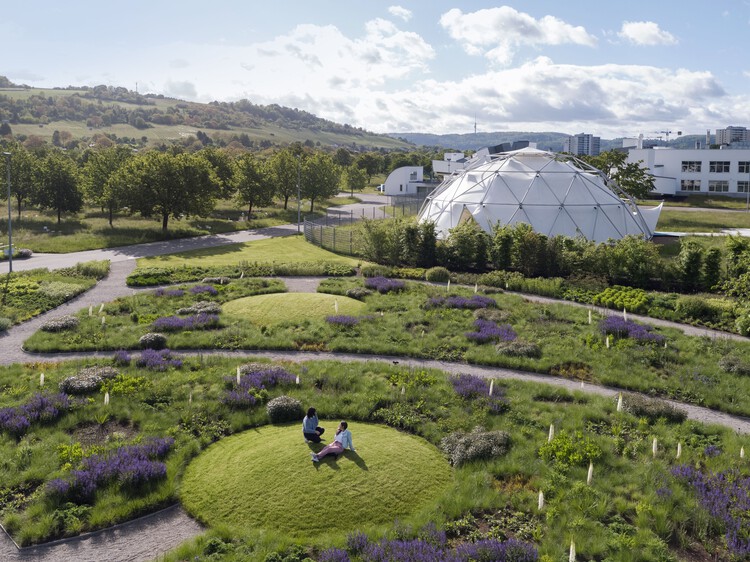
-
Designers: Piet Oudolf
- Area: 4000 m²
- Year: 2020
-
Photographs:Julien Lanoo

Text description provided by the architects. The planting activity for a new garden by the Dutch designer Piet Oudolf started in May 2020 on the Vitra Campus in Weil am Rhein. It will take some patience for the landscaping to reach full bloom, but in just a few months visitors will be able to enjoy initial glimpses of the artfully composed wilderness. The 75-year-old Dutchman is regarded as a pioneer for a generation of garden designers who in the late 1980s began to question conventional practices, finding traditional landscape gardening too decorative, labor-intensive and resource-consuming. Instead, they turned to perennial, often self-regenerating plants, shrubs, grasses, bushes and wildflowers, which had been long ignored as garden plants, and favored an equally unconventional layout of the plantings.


Oudolf does not see himself as the founder of a movement. I leave it to others to say what I am. For some people, I'm just a gardener, he remarks matter-of-factly. A gardener, however, who has been entrusted with the design of public gardens around the world over the past decades including commissions for Hauser & Wirth Somerset, the Serpentine Galleries and the Venice Biennale - and whose High Line in New York initiated a new discourse on gardening in the city.

"In the first decades of the Vitra Campus's development, landscape design was not an issue. It was only in the course of connecting the northern and southern parts of the Campus, when the projects by Álvaro Siza (Siza Promenade) and Günther Vogt were commissioned, that landscape interventions were first implemented. Piet Oudolf's garden adds a fresh dimension to the Campus and opens up a new, ever-changing experience for visitors, explains Rolf Fehlbaum, Chairman Emeritus of Vitra. What Oudolf's projects have in common is the idea of a landscape that looks wild and untamed, but which could not exist in this form without meticulous planning and equally careful maintenance. His designs play with certain societal notions of wilderness. I'm really just trying to turn people's fantasies into reality, he says. Yet his gardens are not wild at all. Rather, he strives to achieve a balanced composition, or community as he calls it, of plants with distinct strengths and weaknesses and different flowering periods and life cycles, so that his gardens provide a sensual experience all year round and accentuate decay as much as high-season phases.


This requires painstaking organization, involving a precise timetable and an intensive search for the right plants and potential suppliers, in addition to a planting scheme that, in the case of Piet Oudolf, looks like a work of art in itself. The same can be said of the drawing that forms the basis for Oudolf's project on the Vitra Campus, Around 30,000 plants will be used, including specimens with such mysterious names as Persicaria amplexicaul Alba', Echinacea pallida "Hula Dancer or Molinia purple moor grass ('Moorhexe'). They supply the framework for the garden, which largely dispenses with built structures, but also declines to serve as mere decoration for the surrounding architecture. Instead, the landscaping complements the buildings and imbues them with new perspectives, as Oudolf emphasizes.

The garden is intended to draw the attention of visitors from the buildings down to the ground, creating a state of inspiring disorientation. The viewer walks between the plants along winding paths - searching in vain for a strict geometry with straight lines and a clear focal point. "I want people to lose themselves in the garden instead of just passing through if says Oudolf, who is keen to ensure that visitors to his gardens experience the same thing he does - namely an encounter that is as emotional as it is aesthetic.
For Piet Oudolf, a former bartender and fishmonger, plants are more than just organic matter that he uses to embellish his gardens. His relationship with the plant world, he says, borders on obsession. His expertise meanwhile rivals that of a botanist, but he applies it more in the manner of a theatre director. ‘To me, plants are personalities that I can use and arrange according to their appearance and behavior. Each one performs" in its own way, but in the end, an interesting play needs to emerge from it.’ If the weather and other global circumstances cooperate, the initial results of these floral theatre rehearsals should start to become visible on the Vitra Campus by September. But this is only the beginning of something, explains Oudolf. "It's not making a painting and putting it on the wall. It's making a painting and letting it grow and decay.






























